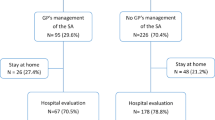Abstract
Although a previous suicide attempt constitutes a major risk factor for an eventual completed suicide, few interventions specifically designed to prevent suicide reattempts have been evaluated. The aim of this study was to determine the effectiveness of case management for the prevention of suicide reattempts. A total of 4,765 subjects with a recent suicide attempt referred from medical and non-medical organizations were consecutively recruited from July 2006 to June 2008. The suicide prevention program of Kaohsiung Suicide Prevention Center (KSPC) provided case management and followed up suicide-attempt cases for 6 months. Survival analysis showed that the risk of suicide reattempt was significantly lower in the case management group than in the non-contact group throughout a six-month follow-up period (hazard ratio = 2.93; 95% CI = 2.47–3.47). The hazard ratio (HR) of the Cox proportional hazard model for sex was 0.77 (95% CI = 0.65–0.91). Case management appears to be effective in preventing suicide reattempts in patients with a recent prior attempt. In addition, case management appeared to be more beneficial in preventing suicide reattempts in male subjects.


Similar content being viewed by others
References
Ahlbom, A. (1993). Biostatistics for epidemiologists. Florida: Lewis Publishers.
Brown, K. G., Beck, A. T., Steer, R. A., et al. (2000). Risk factors for suicide in psychiatric outpatients: A 20-year prospective study. Journal of Consulting and Clinical Psychology, 6, 371–377.
Cedereke, M., Monti, K., Ojehagen, A., et al. (2002). Telephone contact with patients in the year after a suicide attempt: does it affect treatment attendance and outcome? A randomized controlled study. Eur Psychiatry, 17, 82–91.
Chen, W. J., Chen, C. T., Ho, C. K., et al. (2009). The suitability of the BSRS-5 for assessing the elderly who have attempted suicide need to be referred to mental health professional consultation in a metropolitan city. Taiwan. International Journal of Geriatric Psychiatry, 24, 1151–1157.
Cheng, T. A. (1989). Psychosocial stress and minor psychiatric morbidity: A community study in Taiwan. Journal of Affective Disorders, 17, 137–152.
Crump, A. (2006). Suicide in Japan. The Lancet, 367, 1143.
Department of Health Executive, Taiwan. (2006). Profile of the Taiwan region: 10 leading causes of death structured by age. Death statistic results summary 2006 [http://www.doh.gov.tw].
Goldney, R. D. (2005). Suicide prevention: A pragmatic review of recent studies. Crisis, 26, 128–140.
Guillaume, V., Francois, D., Philippe, M., et al. (2006). Effect of telephone contact on further suicide attempts in patients discharged from an emergency department: randomized controlled study. BMJ, 332, 1241.
Guthrie, E., Kapur, N., Mackway-Jones, K., et al. (2001). Randomised controlled trial of brief psychological intervention after deliberate self poisoning. BMJ, 323, 135–138.
Harris, E. C., & Barraclough, B. (1997). Suicide as an outcome for mental disorders: A meta-analysis. The British Journal of Psychiatry, 170, 205–228.
Henriques, G., Wenzel, A., Brown, G. K., et al. (2005). Suicide attempters’ reaction to survival as a risk factor for eventual suicide. The American Journal of Psychiatry, 162, 2180–2182.
Hobfoll, S. E. (1989). Conservation of resources: A new attempt at conceptualizing stress. The American Psychologist, 44, 513–524.
Holley, H. L., Fick, G., & Love, E. J. (1998). Suicide following an inpatient hospitalization for a suicide attempt: A Canadian follow-up study. Social Psychiatry and Psychiatric Epidemiology, 33, 543–551.
Inoue, K., Tanii, H., Fukunaga, T., et al. (2008). The importance of the frequency of suicide attempts as a risk factor of suicide. Journal of Forensic and Legal Medicine, 15, 24–26.
Lin, J. J., & Lu, T. H. (2008). Suicide mortality trends by sex, age and method in Taiwan 1971–2005. BMC Public Health, 8, 6.
Lung, F. W., & Lee, M. B. (2008). The five-item brief-symptom rating scale as a suicide ideation screening instrument for psychiatric inpatients and community residents. BMC Psychiatry, 8, 53.
Moscicki, E. K. (1997). Identification of suicide risk factors using epidemiologic studies. Psychiatric Clinics of North America, 20, 499–517.
Motto, J., & Bostrom, A. (2001). A randomized control trial of post crisis suicide prevention. Psychological Services, 52(6), 828–833.
Nock, M. K., Borges, G., & Bromet, E. J. (2008). Cross-national prevalence and risk factors for suicidal ideation, plan, and attempts in the WHO world mental health surveys. The British Journal of Psychiatry, 192, 98–105.
Oquendo, M. A., Waternaux, C., Brodsky, B., et al. (2000). Suicidal behavior in bipolar mood disorder: Clinical characteristics of attempters and nonattempters. Journal of Affective Disorders, 59, 107–117.
Reid, W. H. (2009). Prognosis after suicide attempt: Standard of care and the consequences of not meeting it. Journal of Psychiatric Practice, 15, 141–144.
Thornicroft, G. (1991). The concept of case management for long-term mental illness. International Review of Psychiatry, 3, 125–132.
Walsh, E., Harvey, K., White, I., et al. (2001). Suicidal behavior in psychosis: Prevalence and predictors from a randomized controlled trial of case management. The British Journal of Psychiatry, 178, 255–260.
Acknowledgments
This research was supported in part by the Kaohsiung Suicide Prevention Program (KSPP) and the Kaohsiung City Government Bureau of Health, Kaohsiung, Taiwan, R.O.C.
Author information
Authors and Affiliations
Corresponding author
Rights and permissions
About this article
Cite this article
Chen, WJ., Chen, CC., Ho, CK. et al. Community-Based Case Management for the Prevention of Suicide Reattempts in Kaohsiung, Taiwan. Community Ment Health J 48, 786–791 (2012). https://doi.org/10.1007/s10597-012-9480-7
Received:
Accepted:
Published:
Issue Date:
DOI: https://doi.org/10.1007/s10597-012-9480-7




